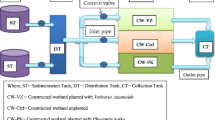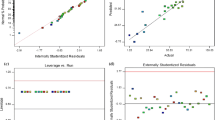Abstract
Water pollution is a global problem. During current study, ammonia, phosphate, phenol, and copper(II) were removed from aqueous solution by subsurface and surface flow constructed wetland. In current investigation, distilled water was polluted with four contaminants including ammonia, phosphate, copper (Cu), and phenol. Response surface methodology and central composite design were applied to optimize pollutant removal during treatment by subsurface flow constructed wetland (SSFCW). Contact time (12 to 80 h) and initial pollutant concentration (20 to 85 mg/L) were selected as independent factors; some upper and lower ranges were also monitored for accuracy. In SSFCW, water hyacinth transplanted in two substrate layers, namely zeolite and cockle shell. SSFCW removed 87.7, 81.4, 74.7, and 54.9% of ammonia, phosphate, Cu, and phenol, respectively, at optimum contact time (64.5 h) and initial pollutant concentration (69.2 mg/L). Aqueous solution was moved to a surface flow constructed wetland (SFCW) after treating via SSFCW at optimum conditions. In SFCW, Typha was transplanted to a fixed powdered substrate layer, including bentonite, zeolite, and cockle shell. SFCW could develop performance of this combined system and could improve elimination efficacy of the four contaminants to 99.99%. So this combined CW showed a good performance in removing pollutants.

Wetlands arrangement for treating aqueous solution in current study



Similar content being viewed by others
References
Abou-Elelaa, S. I., Golinielli, G., Abou-Taleb, E. M., & Hellal, M. S. (2013). Municipal wastewater treatment in horizontal and vertical flows constructed wetlands. Ecological Engineering, 61, 460–468.
Anning, A. K., Korsah, P. E., & Addo-Fordjour, P. (2013). Phytoremediation of wastewater with Limnocharis flava, Thalia geniculata and Typha latifolia in constructed wetlands. International Journal of Phytoremediation, 15, 452–464.
APHA. (2005). Standard methods for the examination of water and wastewater (21st ed.). Washington DC: American public health association.
Ashrafizadeh, S. N., & Khorasani, Z. (2010). Ammonia removal from aqueous solutions using hollow-fiber membrane contactors. Chemical Engineering Journal, 162, 242–249.
Atieh, M. A. (2014). Removal of phenol from water different types of carbon—a comparative analysis. APCBEE Procedia, 10, 136–141.
Aydın, H., Bulut, Y., & Yerlikaya, C. (2008). Removal of copper (II) from aqueous solution by adsorption onto low-cost adsorbents. Journal Environmental Management, 87, 37–45.
Ballantine, D. J., & Tanner, C. C. (2010). Substrate and filter materials to enhance phosphorus removal in constructed wetlands treating diffuse farm runoff: a review. New Zealand Journal of Agricultural Research, 53, 71–95.
Beebe, D. (2013). Renovation of ammonia contaminated produced water using constructed wetlands. PhD Thesis, Clemson University.
Brix, H., Arias, C. A., & del Bubba, M. (2014). Media selection for sustainable phosphorus removal in subsurface flow constructed wetlands. Water Science & Technology, 44(11–12), 47–54.
Brooks, A. S., Rozenwald, M. N., Geohring, L. D., Lion, L. W., & Steenhuis, T. S. (2000). Phosphorus removal by wollastonite: a constructed wetland substrate. Ecological Engineering, 15, 121–132.
Campbell, C. R., & Plank, C. O. (1998). Preparation of plant tissue for laboratory analysis. In Y. P. Kalra (Ed.), Handbook of reference method for plant analysis (pp. 37–49). Boca Raton: CRC Press.
Chehregani, A., Noori, M., & Yazdi, H. L. (2009). Phytoremediation of heavy-metal-polluted soil: screening for new accumulator plants in Anouran mine (Iran) and evaluation of removal ability. Ecotoxicology and Environmental Safety, 72, 1349–1353.
Environmental Quality (Sewage, Industrial Effluents) Regulation (2009) Malaysian Environmental Quality Act 1974, Standards A.
EPA. (2013). Aquatic life ambient water quality criteria for ammonia–freshwater. Washington, DC: U.S. Environmental Protection Agency, Office of Water, Office of Science and Technology EPA-822-R-13-001.
Forbes, M.G., Yelderman, J.C., Potterton, T., Clapp, A., Doyle, R.D., & Golden, T.D. (2009). Improving ammonia and phosphorus removal in subsurface flow wetlands. Presented to Texas On-Site Wastewater Treatment Research Council, USA.
Halim, A. A., Latif, M. T. L., & Ithnin, A. (2013). Ammonia removal from aqueous solution using organic acid modified activated carbon. World Applied Sciences Journal, 24, 01–06.
Hegazy, A. K., Abdel-Ghani, N. T., & El-Chaghaby, G. A. (2011). Phytoremediation of industrial wastewater potentiality by Typha domingensis. International journal of Environmental Science and Technology, 8, 639–648.
Hussain, S. I., Blowes, D. W., Ptacek, C. J., Jamieson-Hanes, J. H., Wootton, B., Balch, G., & Higgins, J. (2015). Mechanisms of phosphorus removal in a pilot-scale constructed wetland/BOF slag wastewater treatment system. Environmental Engineering Science, 32(4), 1–13.
Jadia, C. D., & Fulekar, M. H. (2009). Phytoremediation of heavy metals: recent techniques. African Journal of Biotechnology, 8, 921–928.
Kantawanichkul, S., & Wannasri, S. (2013). Wastewater treatment performances of horizontal and vertical subsurface flow constructed wetland systems in tropical climate. Songklanakarin Journal of Science and Technology, 35, 599–603.
Kotze, D. C. (2000). Wetlands and water quality enhancement. Pretoria: For the Mondi Wetlands Project.
Kyambadde, J., Kansiime, F., & Dalhammar, G. (2005). Nitrogen and phosphorus removal in substrate-free pilot constructed wetlands with horizontal surface flow in Uganda. Water, Air, & Soil Pollution, 165, 37–59.
Liao, S., & Chang, W. (2004). Heavy metal phytoremediation by water hyacinth at constructed wetlands in Taiwan. Photogrammetric Engineering & Remote Sensing, 54, 177–185.
Lu, S., Gibb, S. W., & Cochrane, E. (2007). Effective removal of zinc ions from aqueous solutions using crab carapace biosorbent. Journal of Hazardous Materials, 149, 208–217.
Malik, R. N., Husain, S. Z., & Nazir, I. (2010). Heavy metal contamination and accumulation in soil and wild plant species from industrial area of Islamabad, Pakistan. Pakistan Journal of Botany, 42, 291–301.
Md Sa’at, S.K.B. (2006). Subsurface flow and free water surface flow constructed wetland with magnetic field for Leachate treatment. MSc Thesis, Universiti Teknologi Malaysia.
Mena, J., Rodriguez, L., Nuñez, J., Fernández, F. J., & Villaseñor, J. (2008). Design of horizontal and vertical subsurface flow constructed wetlands treating industrial wastewater. WIT Transactions on Ecology and the Environment, 111, 555–564.
Mohebbi, A. H., Harutyunyan, S. S., & Chorom, M. (2012). Phytoremediation potential of three plant grown in monoculture and intercrop** with date palm in contaminated soil. International Journal of Agriculture and Crop Sciences, 4, 1523–1530.
Mojiri, A. (2012). Phytoremediation of heavy metals from municipal wastewater by Typha domingensis. African Journal of Microbiology Research, 6, 643–647.
Mojiri, A., Aziz, H. A., Zahed, M. A., Aziz, S. Q., & Selamat, M. R. B. (2013). Phytoremediation of heavy metals from urban waste leachate by southern cattail (Typha domingensis). International Journal of Scientific Research in Environmental Sciences, 1, 63–70.
Mojiri, A., Aziz, H. A., Zaman, N. Q., Aziz, S. Q., & Zahed, M. A. (2014). Powdered ZELIAC augmented sequencing batch reactors (SBR) process for co-treatment of landfill leachate and domestic wastewater. Journal Environmental Management, 139, 1–14.
Mojiri, A., Aziz, H. A., Ziyang, L., Nanwen, Z., Tajuddin, R. M., Aziz, S. Q., & Dongdong, G. (2015). Zeolite and activated carbon combined with biological treatment for metals removal from mixtures of landfill leachate and domestic wastewater. Global NEST Journal, 17, 727–373.
Mojiri, A., Ziyang, L., Tajuddin, R. M., Farraji, H., & Alifar, N. (2016). Co-treatment of landfill leachate and municipal wastewater using the ZELIAC/zeolite constructed wetland system. Journal of Environmental Management, 166, 124–130.
Mwanyika, F. T., Ogendi, G. M., & Kipkemboi, J. K. (2016). Removal of heavy metals from wastewater by a constructed wetland system at Egerton University, Kenya. IOSR Journal of Environmental Science, Toxicology and Food Technology, 10, 15–20.
Najafpoor, A. A., Dousti, S., Jafari, A. J., & Hosseinzadeh, A. (2016). Efficiency in phenol removal from aqueous solutions of pomegranate peel ash as a natural adsorbent. Environ. Environmental Health Engineering and Management Journal, 3, 41–46.
Nelson, E. A., Specht, W. L., & Knox, A. S. (2006). Metal removal from water discharges by a constructed treatment wetland authors. Engineering in Life Sciences, 6, 26–30.
Office of Water Programs (2009). Ammonia removal in wetlands: a literature review. Prepared for Sacramento Regional County Sanitation District, California State University Sacramento.
Okunowo, W. O., & Ogunkanmi, L. A. (2010). Phytoremediation potential of some heavy metals by water hyacinth. International Journal of Biological and Chemical Sciences, 4, 347–353.
Rengel, Z., Graham, R. D., & Pedler, J. F. (1993). Manganese nutrition and accumulation of phenolics and lignin as related to differential resistance of wheat genotypes to the take-all fungus. Plant and Soil, 151, 255–263.
Rezania, S., Ponraj, M., Talaiekhozani, A., Mohamad, S. E., Din, M. F. M., Taib, S. T., Sabbagh, F., & Sairan, F. M. (2015). Perspectives of phytoremediation using water hyacinth for removal of heavy metals, organic and inorganic pollutants in wastewater. Journal of Environmental Management, 163, 125–133.
Rodrigues, L. A., Campos, T. M. B., Alvarez-Mendes, M. O., Coutinho, A. D., Sakane, K. K., & Thim, G. P. (2012). Phenol removal from aqueous solution by carbon xerogel. Journal of Sol-Gel Science and Technology, 63, 202–210.
Shehzadi, M., Afzal, M., Khan, M. U., Islam, E., Mobin, A., Anwar, S., & Khan, Q. M. (2014). Enhanced degradation of textile effluent in constructed wetland system using Typha domingensis and textile effluent-degrading endophytic bacteria. Water Research, 58, 152–159.
Shrivastava, A. K. (2009). A review on copper pollution and its removal from water bodies by pollution control techniques. Indian Journal of Environmental Protection, 29, 552–560.
Song, X., Pan, Y., Wu, Q., Cheng, Z., & Ma, W. (2011). Phosphate removal from aqueous solutions by adsorption using ferric sludge. Desalination, 280, 384–390.
Umar, M., Aziz, H. A., & Yusoff, M. S. (2011). Assessing the chlorine disinfection of landfill leachate and optimization by response surface methodology (RSM). Desalination, 274, 278–283.
Victor, K. K., Séka, Y., Norbert, K. K., Sanogo, T. A., & Celestin, A. B. (2016). Phytoremediation of wastewaters toxicity using water hyacinth (Eichhornia crassipes) and water lettuce (Pistia stratiotes). International Journal of Phytoremediation, 18(10), 949–955.
Vymazal, J. (2010). Constructed wetlands for wastewater treatment. Water, 2, 530–549.
Vymazal, J. (2004). Removal of phosphorus in constructed wetlands with horizontal sub-surface flow in the Czech Republic. Water, Air and Soil Pollution: Focus, 4, 657–670.
Vymazal, J., Brix, H., Cooper, P.F., Haberl, R., Perfler, R., & Laber, J. (1998). Removal mechanism types of constructed wetlands. In J. Vymazal (Ed.), Constructed wetlands for wastewater treatment in Europe (pp. 17–66). Leiden: Backhuy Publishers.
Vymazal, J., & Kröpfelová, L. (2008). Wastewater treatment in constructed wetlands with horizontal sub-surface flow. Dordrecht: Springer.
Wastewater Gardens. (2010). Constructed wetlands to treat wastewater, framework and schematic overview. Information Sheet, IS20120105, pp. 26.
Xu, K., Deng, T., Liu, J., & Peng, W. (2010). Study on the phosphate removal from aqueous solution using modified fly ash. Fuel, 89, 3668–3674.
Yalcuk, A. (2011). Removal of phenol from olive mill wastewater in constructed wetlands using different bedding media. Ekoloji, 80, 1–5.
Yalcuk, A., & Ugurlu, A. (2009). Comparison of horizontal and vertical constructed wetland systems for landfill leachate treatment. Bioresource Technology, 100, 2521–2526.
Acknowledgements
The authors would like to express their gratitude to the Institute for Infrastructure Engineering and Sustainable Management (IIESM), Universiti Teknologi Mara (UiTM), for their supports.
Author information
Authors and Affiliations
Corresponding author
Additional information
1- Pollutants were removed from aqueous solution by subsurface and surface flow constructed wetland (CW).
2- RSM and CCD were utilized for optimization.
3- At the optimum condition for subsurface flow CW, removal efficacies of ammonia, phosphate, phenol and Cu were 87.7, 81.4, 74.7, and 54.9%.
4- After treating at optimum performance via subsurface flow CW, wastewater was moved to surface flow CW which could improve removal efficiencies.
Electronic supplementary material
ESM 1
(PDF 2981 kb)
Rights and permissions
About this article
Cite this article
Mojiri, A., Ahmad, Z., Tajuddin, R.M. et al. Ammonia, phosphate, phenol, and copper(II) removal from aqueous solution by subsurface and surface flow constructed wetland. Environ Monit Assess 189, 337 (2017). https://doi.org/10.1007/s10661-017-6052-x
Received:
Accepted:
Published:
DOI: https://doi.org/10.1007/s10661-017-6052-x




